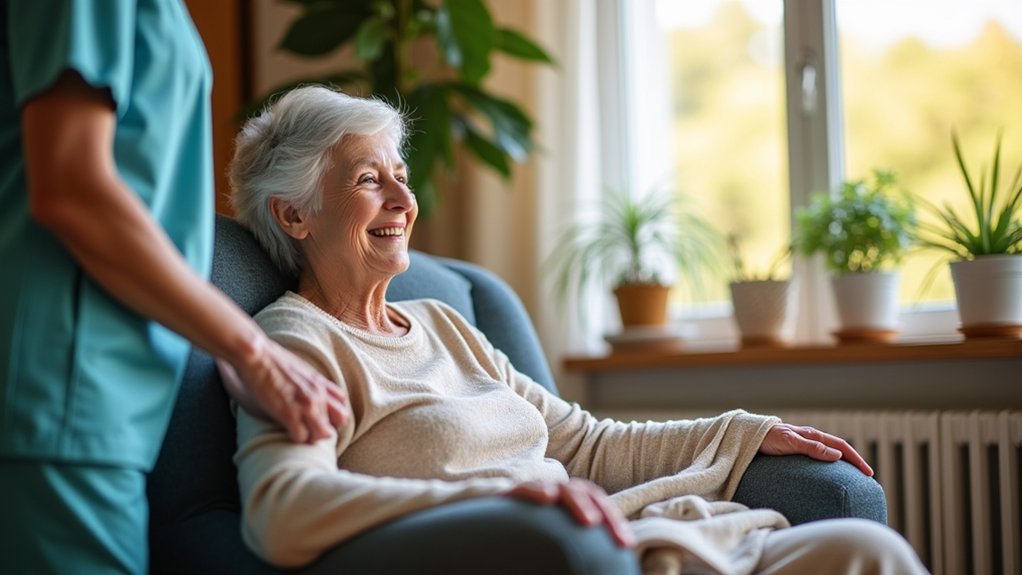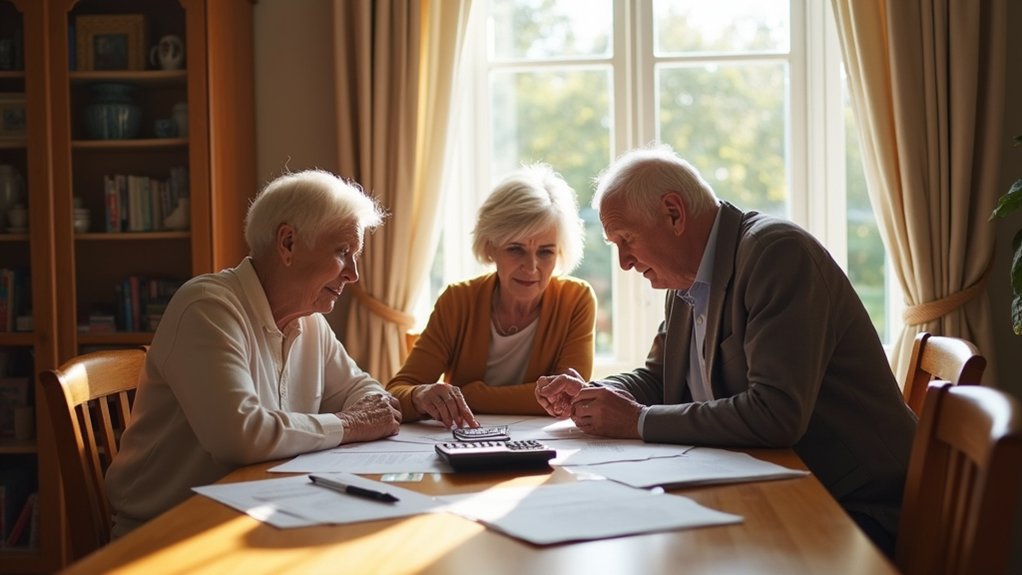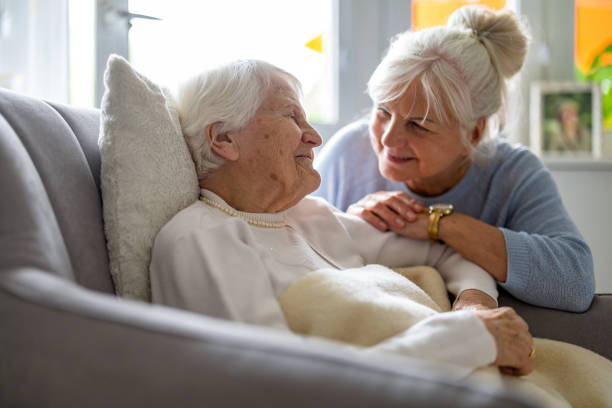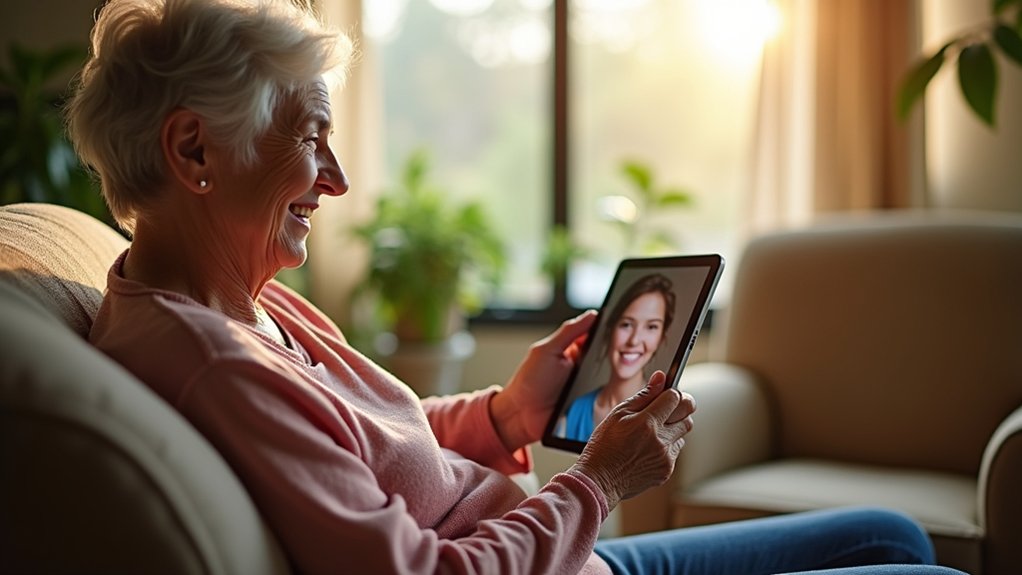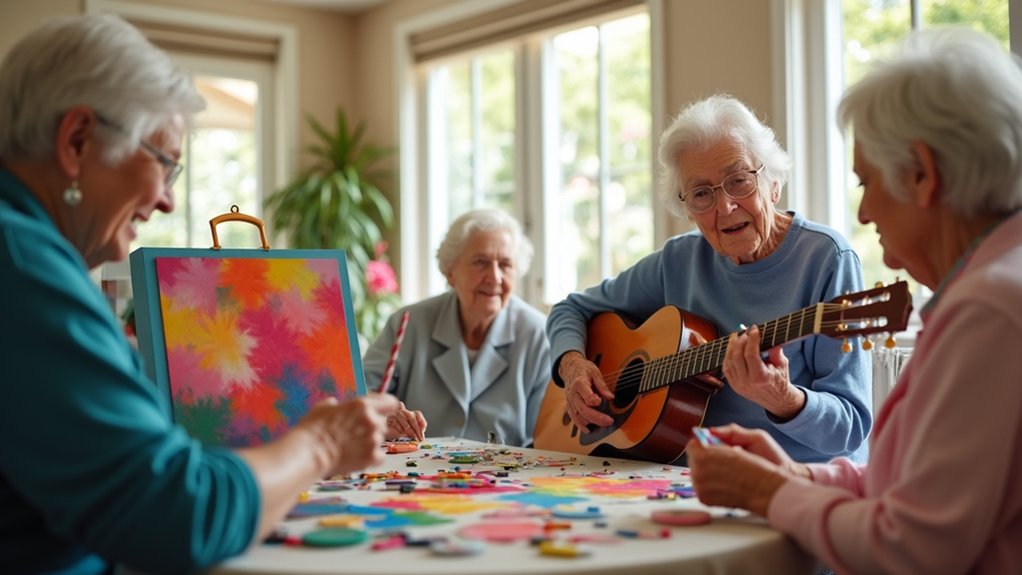Physical fitness plays a key role in assisted living, and you can boost your health with simple routines. Staying active improves your mood, strengthens your body, and connects you with others through group activities like chair aerobics. Try easy exercises such as seated leg lifts or morning stretches to enhance flexibility and reduce fall risks. Tailored programs can meet your unique needs. Stick with us to uncover more ways to thrive!
Key Takeaways
- Physical fitness in assisted living boosts health, mood, and community connections through simple routines.
- Morning stretches and chair-based exercises enhance flexibility and reduce fall risks safely.
- Tailored programs address mobility challenges, promoting strength and independence for seniors.
- Group fitness sessions like chair aerobics foster social engagement and combat loneliness.
- Starting with gentle activities and listening to the body ensures safety and motivation.
Benefits of Staying Active in Assisted Living
As you settle into life in assisted living, staying active can greatly enhance your overall well-being. By engaging in regular physical activity, you’re not only boosting your health but also inspiring those around you in communities like assisted living Warwick RI.
Exercise lifts your mood, strengthens your body, and fosters connections with others who share your desire to serve and support. Additionally, incorporating simple morning stretches into your routine can improve flexibility and reduce the risk of falls.
If you’re searching for assisted living near me, consider options in senior living Warwick RI, where programs often encourage staying active.
Join group walks or fitness classes to build energy and camaraderie. Your commitment to movement can motivate peers, creating a ripple effect of care and encouragement.
Keep moving, and you’ll thrive while uplifting everyone nearby.
Understanding Mobility Challenges for Seniors
While aging brings wisdom, it can also introduce mobility challenges that impact daily life in assisted living.
As someone dedicated to serving seniors, you’ll notice how joint stiffness, muscle weakness, or balance issues can limit their independence.
These hurdles often make simple tasks like walking or climbing stairs feel intimidating.
Your understanding and empathy are essential in places like assisted living in Warwick RI, where residents rely on support to navigate these struggles. Additionally, personalized care is crucial in addressing each resident’s unique mobility needs and ensuring they receive the appropriate assistance.
Tailored Exercise Programs for Different Needs
Since mobility challenges vary widely among seniors, tailored exercise programs are essential in assisted living settings. You can make a real difference by evaluating each resident’s unique needs and abilities.
Start by collaborating with healthcare professionals to design routines that enhance strength, balance, and flexibility while respecting individual limitations.
Begin by partnering with healthcare experts to craft routines that boost strength, balance, and flexibility, always honoring each senior’s unique limitations.
As you create these programs, focus on activities that promote overall well-being, like gentle stretching or light resistance training. Adjust the intensity and duration to match each person’s capacity, ensuring safety and encouragement.
Incorporating nutrient-dense meals into their nutrition plans can further support their physical fitness and overall health.
Your dedication to personalizing fitness plans fosters confidence and independence in seniors. By listening and adapting, you’re not just improving physical health—you’re uplifting spirits and building meaningful connections in their daily lives.
Chair-Based Workouts for Limited Mobility
When mobility is a challenge for seniors in assisted living, chair-based workouts offer a practical and effective solution. You can help by guiding them through simple exercises right from their seat, ensuring they stay active safely.
Start with arm raises—have them lift their arms overhead for 10 reps to build shoulder strength. Next, encourage seated leg lifts, extending one leg at a time to improve circulation and muscle tone.
You’re making a difference by assisting with chair marches, where they lift knees alternately as if marching, boosting heart health. Add gentle torso twists to enhance flexibility. Regular engagement through such activities not only improves physical fitness but also fosters emotional support that enhances overall well-being.
With your support, they’ll feel stronger and more confident. Keep sessions short, around 10-15 minutes, and always prioritize their comfort and safety.
Walking and Balance Activities for Daily Strength
As mobility varies among seniors in assisted living, focusing on walking and balance activities can greatly boost daily strength. You can make a difference by guiding them through simple routines.
Encourage short walks around the community, using handrails or a walker for support if needed. Start with just a few minutes and gradually increase the time as they build confidence.
Help them practice balance by standing near a sturdy surface and gently shifting weight from one foot to another. You’ll see their stability improve with consistent effort.
Support their balance by guiding them to stand near a stable surface and shift weight between feet. Consistency will enhance their stability over time.
These activities not only strengthen muscles but also enhance independence, allowing those you serve to navigate daily tasks with greater ease. Additionally, the favorable resident-to-staff ratio at Commonwealth House allows for personalized attention during these routines. Your support can truly transform their quality of life.
Stretching Routines to Improve Flexibility
Flexibility plays an essential role in maintaining mobility for seniors in assisted living. As someone dedicated to helping others, you can guide them through simple stretching routines to ease stiffness and improve range of motion.
Start with gentle neck stretches by having them slowly tilt their head side to side. Encourage arm reaches to loosen shoulders, lifting one arm overhead and holding for 10 seconds.
Next, assist with seated leg stretches to target hips and hamstrings. Help them extend one leg forward, keeping it straight, and lean slightly toward their toes.
Remind them to breathe deeply and never force a stretch. With your support, these daily practices can boost their comfort and independence in everyday movements. Additionally, incorporating art therapy into their routine can further enhance their emotional wellness and overall quality of life.
Group Fitness Sessions for Social Engagement
While individual exercises are beneficial, joining group fitness sessions can greatly enhance social engagement for seniors in assisted living. You can play an essential role by encouraging participation in these activities, fostering a sense of community.
Organize or join classes like chair aerobics or gentle yoga, where you’ll connect with others while staying active. These sessions aren’t just about fitness; they’re a chance to build friendships and combat loneliness.
As you guide or participate, smile and chat with peers during breaks to create a warm atmosphere. Help newcomers feel welcome by pairing them with a buddy. Additionally, these group activities align with the community’s commitment to maintaining independence and dignity for residents, making fitness a holistic part of their well-being.
Your efforts in promoting group fitness can transform lives, turning exercise into a shared joy that strengthens both body and spirit.
Tips for Safely Starting a Fitness Journey
Before you plunge into a new fitness routine in assisted living, take a moment to prioritize safety. Consult your doctor first to verify you’re ready for physical activity, especially if you’ve got existing health concerns. Their guidance can help you avoid injury while supporting others in your community.
Start slow with gentle exercises like walking or chair stretches, and don’t push beyond your limits. Use proper equipment, like supportive shoes, to prevent falls. Partner with staff or peers for encouragement and accountability—your journey can inspire others! Additionally, consider discussing your fitness goals with staff to explore how personalized care plans can support your fitness journey and overall well-being.
Listen to your body; if you feel pain, stop and reassess. By taking these steps, you’ll build strength safely and be a role model for those around you in assisted living.
Frequently Asked Questions
How Does Diet Support Physical Fitness in Assisted Living?
Hey there, let’s talk about how diet supports physical fitness for those in assisted living.
You’ve got the power to help by ensuring balanced meals packed with protein, vitamins, and minerals. Encourage hydration and offer nutrient-rich snacks to boost energy for exercise.
Tailor diets to their needs, and you’re fueling their strength and mobility.
Keep communicating with them; you’ll see how proper nutrition transforms their daily liveliness and joy!
What Role Do Caregivers Play in Fitness Routines?
When considering what role caregivers play in fitness routines, you’re at the heart of making a difference. You guide and encourage residents with patience, ensuring they feel supported during exercises.
You’ll adapt routines to their needs, keep them motivated, and celebrate every small victory. You’re not just helping with physical health; you’re building trust and joy.
Keep inspiring them daily, and you’ll see their strength and confidence grow!
Can Technology Aid Seniors in Fitness Tracking?
Hey, you can make a real difference by helping seniors use technology for fitness tracking!
Encourage them to wear smartwatches or use apps that monitor steps, heart rate, and activity levels. Show ’em how to set goals and celebrate small wins.
You’re empowering them to stay active and healthy! With your guidance, they’ll feel supported and motivated, knowing someone’s cheering them on every step of the way.
How Often Should Fitness Goals Be Reassessed?
Hey, let’s talk about how often you should reassess your fitness goals.
Don’t wait too long—check in every 4 to 6 weeks to see how you’re doing. Adjust based on your progress or any challenges you’re facing.
You’re helping others by staying strong, so keep track of what’s working. Stay proactive, tweak your plan as needed, and you’ll keep making a positive impact on those around you!
Are There Mental Health Benefits to Fitness?
Hey, have you ever wondered if fitness boosts your mental health? Absolutely, it does!
When you’re active, you’re not just strengthening your body; you’re lifting your spirits too. Exercise releases endorphins, helping you feel happier and less stressed.
You’ll notice improved focus and a brighter outlook. By staying active, you’re caring for others by being your best self—emotionally strong and ready to support those who need you most.

